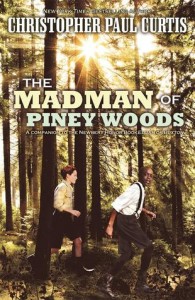The Madman of the Piney Woods and How it Went Down
 Curtis’ companion novel to ELIJAH OF BUXTON is an equally excellent stand alone, which shares much of what made its predecessor distinguished: unique voices that take their time, building deep familiarity with character and setting so that–in this case–a fairly simple but highly dramatic plot line supports a complex coming-of-age in the two main characters. Like ELIJAH, this book requires a reader who will let the story take its time to deliver; but it never wanders, or takes too long. The attention to detail helps the historical setting and perspective become fully realized, and the sense of humor makes the story feel real, and keeps the reader engaged. Though the lessons learned are horrifying, they are presented in a way fully appropriate for the intended audience. This one shoots right up into my top picks.
Curtis’ companion novel to ELIJAH OF BUXTON is an equally excellent stand alone, which shares much of what made its predecessor distinguished: unique voices that take their time, building deep familiarity with character and setting so that–in this case–a fairly simple but highly dramatic plot line supports a complex coming-of-age in the two main characters. Like ELIJAH, this book requires a reader who will let the story take its time to deliver; but it never wanders, or takes too long. The attention to detail helps the historical setting and perspective become fully realized, and the sense of humor makes the story feel real, and keeps the reader engaged. Though the lessons learned are horrifying, they are presented in a way fully appropriate for the intended audience. This one shoots right up into my top picks.
 And the audience question makes me think of it alongside another top pick I keep on not mentioning just because I know it will be a very hard sell. HOW IT WENT DOWN by Kekla Magoon is an amazing multi-voice novel following characters who witness a lethal shooting on an urban street. Multi-voice narratives are hard to pull off…they tend to be uneven, or the opposite: you can’t tell the characters apart. Magoon convincingly carries a wide array of distinct and engaging voices, and realistically approaches a complex story about guilt, restitution, community, and free will. The reviews all call this book “14 and up”; I would call it “12 and up,” but regardless, it is certainly a book for a YA audience. I believe it is also a book for a child audience, within the definition of the Newbery. Magoon manages a very fine approach that shows the struggles of each character in a way that is understandable to 12-14 audience, especially for those 12-14 year olds who witness all of the challenges Magoon’s characters are witnessing, everyday. This is the book that may help them make sense of some of it.
And the audience question makes me think of it alongside another top pick I keep on not mentioning just because I know it will be a very hard sell. HOW IT WENT DOWN by Kekla Magoon is an amazing multi-voice novel following characters who witness a lethal shooting on an urban street. Multi-voice narratives are hard to pull off…they tend to be uneven, or the opposite: you can’t tell the characters apart. Magoon convincingly carries a wide array of distinct and engaging voices, and realistically approaches a complex story about guilt, restitution, community, and free will. The reviews all call this book “14 and up”; I would call it “12 and up,” but regardless, it is certainly a book for a YA audience. I believe it is also a book for a child audience, within the definition of the Newbery. Magoon manages a very fine approach that shows the struggles of each character in a way that is understandable to 12-14 audience, especially for those 12-14 year olds who witness all of the challenges Magoon’s characters are witnessing, everyday. This is the book that may help them make sense of some of it.
One way to look at the age question is… is this 12-14 year old reader, who is both a child and a teen, approaching the book best from the perspective of a child? Or from the perspective of a teen? I think this is a true cusp book: it reads equally excellently from either perspective. Looking at the age level interpretations in the Newbery Manual, it is certainly “exceptionally fine” for this narrow age range. The question is whether it ”does what it sets out to do as well as or better than other, younger books that are also eligible.” I might have to compare it to MADMAN OF THE PINEY WOODS in this case, if we assume that “what it sets out to do” is have the reader comes to terms with violence and racism in their community. It might, however, do it as well, or better. However you or the committee end up feeling about this one being Newbery eligible, I think it makes good comparison to other titles, and is particularly useful for feeling out where that “edge” is on “edgy.”
![]()
RELATED
The job outlook in 2030: Librarians will be in demand
The job outlook in 2030: Librarians will be in demand
ALREADY A SUBSCRIBER? LOG IN
We are currently offering this content for free. Sign up now to activate your personal profile, where you can save articles for future viewing






Add Comment :-
Be the first reader to comment.
Comment Policy:
Comment should not be empty !!!